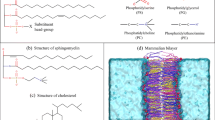Abstract
In order to understand the localization of dyes and the nature of their responses in membranes and particularly in those involved in energy-conservation processes, the influence of micelles of neutral and ionic surfactants on the pK a of solubilized fluorophoric (umbelliferone) and chromophoric (bromthymol blue and methyl red) indicator dyes is studied. It is shown that the pK a of the indicator adsorbed onto micelles shifted towards the acid extreme with cationic micelles, to the alkaline side with anionic micelles while it was not significantly modified by the neutral ones. Maximal displacements were observed with Methyl Red where the difference in pK a between anionic and cationic micelles was as large as 3 pH units. Phospholipid liquid crystals (Liposomes) of phosphatidylcholine with and without adsorbed long-chain ions introduced in order to confer to it a net surface charge induced displacements of the pK a of UBF analogous to those detected in the presence of detergent micelles. It was demonstrated that UBF can monitor reversal of charge phenomena such as that obtained by the interaction of phosphatidylcholine + dicetyl phosphate liposomes (anionic colloid) with poly-L-lysine (cationic colloid). The partition of the indicator dyes between micellar and aqueous phases was determined by gel filtration revealing thequasi exclusive presence of the dyes in the micellar phase. Fluorescence polarization measurement of solubilized UBF in either ionic micelles or submitochondrial particles indicate that the dye tumbling rate is as rapid as in pure water suggesting that the dye is mobile in an interfacial environment where it can experience modifications due to changes in surface potential. The use of UBF as a probe of respiration-dependent energy-linked reactions in submitochondrial particles is presented. The available data on the use of indicator dyes in mitochondrial, chloroplast and bacterial chromatophore membranes is reevaluated, on the basis of the evidence of the extreme sensitivity of these probes to surface charge. The implications of these results and considerations are discussed in terms of the importance of the surface potential in the primary event of the energy-coupling process in oxidative and photosynthetic phosphorylation.
Similar content being viewed by others
References
E. C., Slater,Quart. Rev. Biophys.,4 (1971) 35.
P., Mitchell,Chemiosmotic Coupling in Oxidative and Photosynthetic Phosphorylation. Glynn Research, Bodmin, Cornwall (1966).
P., Mitchell,Chemiosmotic Coupling and Energy Transduction. Glynn Research, Bodmin, Cornwall (1968).
B. Chance and M. Montal, in:Current Topics in Membranes and Transport, F. Bronner and A. Kleinzeller (eds.), Academic Press, N. Y., 1971, Vol. 2, 99–156.
R. J. P. Williams, in:Current Topics in Bioenergetics, D. R. Sanadi (ed.), Academic Press, N. Y.,3 (1969) 79.
V. P. Skulachev, in:Current Topics in Bioenergetics, D. R. Sanadi (ed.), Academic Press, N. Y.,4 (1971) 127.
B. Chance,Proc. Nat. Acad. Sci. U.S. 67, (1970) 560.
G. S. Hartley,Trans. Faraday Soc.,30 (1934) 444.
G. S. Hartley and J. W. Roe,Trans. Faraday Soc.,36 (1940) 101.
P. Mukerjee and K. Banerjee,J. Phys. Chem.,68, (1964) 3367.
A. D. Bangham,Prog. Biophys. Mol. Biol.,18 (1968) 29.
G. Weber and B. Bablonzian,J. Biol. Chem.,241 (1966) 2558.
J. M. Fessenden and S. Racker,Meth. Enzymol.,10 (1967) 194.
C. P. Lee and L. Ernster,Meth. Enzymol.,10 (1967) 543.
E. E. Jacobs, M. Jacob, D. R. Sanadi and L. B. Bradley,J. Biol. Chem.,223 (1956) 147.
W. W. Fish, K. G. Mann and C. Tanford,J. Biol. Chem.,244 (1969) 4989.
M. F. Emerson and A. Holtzer,J. Phys. Chem.,71 (1967) 1898.
D. Chávez, M.S. Thesis. Centro de Investigación y de Estudios Avanzados del Instituto Politécnico Nacional, México (1967).
K. Shinoda, T. Nakagawa, B. I. Tamamushi and T. Isemura,Colloidal Surfactants: Some Physicochemical Properties, Academic Press, N.Y. and London, Chapter 1 (1963).
H. G. Bungenberg de Jong, in:Colloid Science, H. R. Kruyt (ed.), Elsevier Publ. Co. N.Y., Amsterdam, London, Brussels, 1949, Vol. 2, p. 335.
H. K. Kimelberg and D. Papahadjopoulos,J. Biol. Chem.,246 (1971) 1142.
P. Mitchell, J. Moyle and L. Smith,European J. Biochem.,4 (1968) 9.
J. B. Jackson and A. R. Crofts,European J. Biochem.,10 (1969) 226.
D. G. Herries, W. Bishop and F. M. Richards,J. Phys. Chem.,68 (1964) 1842.
G. Weber,Advan. Protein Chem.,8 (1953) 415
B. Rubalcava, D. Martïnez Rojas and C. Gitler,Biochemistry,8 (1969) 2742.
J. T. Davies and E. K. Rideal,Interfacial Phenomena, Academic Press, London, Chapter 2 (1961).
, Chapter 3 (1961).
, p. 146 (1961).
D. Papahadjopoulos and J. C. Watkins,Biochim. Biophys. Acta,135 (1967) 639.
P. Mukerjee and A. Ray,J. Phys. Chem.,70 (1966) 2144.
I. M. Flanagan and S. Ainsworth,Biochim. Biophys. Acta,168 (1968) 16.
J. R. Brocklehurst, R. B. Freedman, D. J. Hancock and G. K. Radda,Biochem. J.,116 (1970) 721.
A. S. Waggoner, O. H. Griffith and C. R. Christensen,Proc. Nat. Acad. Sci. U.S.,57 (1967) 1198.
J. Kumamoto, J. C. Powers and W. R. Heller,J. Chem. Phys.,36 (1962) 2893.
J. R. Platt,J. Chem. Phys.,34 (1961) 862.
W. Liptay,Angew. Chem. Internat. Edit.,8 (1969) 177.
H. M. Emrich, W. Junge and H. T. Witt,Naturwiss.,56 (1969) 514.
B. Chance, A. R. Crofts, M. Nishimura and B. Price,European J. Biochem.,13 (1970) 364.
B. Chance, J. A. McCray and J. BunkenburgNature,225, (1970) 705.
H. H. Grunhagen and H. T. Witt,Z. Naturforsch.,25b (1970) 373.
A. Azzi, B. Chance, G. K. Radda and C. P. Lee,Proc. Nat. Acad. Sci. U.S.,62 (1969) 612.
Author information
Authors and Affiliations
Additional information
A preliminary account of this research has been presented elsewhere (IV International Biophysics Congress of the International Union of Pure and Applied Biophysics, Moscow, August 1972).
Rights and permissions
About this article
Cite this article
Montal, M., Gitler, C. Surface potential and energy-coupling in bioenergy-conserving membrane systems. J Bioenerg Biomembr 4, 363–382 (1973). https://doi.org/10.1007/BF01648978
Received:
Issue Date:
DOI: https://doi.org/10.1007/BF01648978




